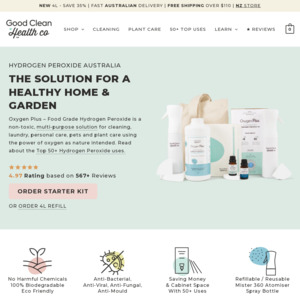Reducing harmful chemicals from your home and garden has never been easier.
The Complete Hydrogen Peroxide for Cleaning and Plant Care Starter Kit is the most versatile, best-value multi-purpose eco-friendly cleaning solution you’ll find.
- Most Versatile Solution – Kitchen, Bathroom, Laundry, General Cleaning, Personal Care, Pets and Plant Care
- Highly Effective – Anti-Bacterial, Anti-Viral, Anti-Fungal, Anti-Mould
- Non-Toxic, Eco Friendly and 100% Biodegradable
- Safe Around Children, Pets and People Suffering from Allergies
- Hydrogen Peroxide Teeth Whitening, Hydrogen Peroxide Mouthwash
But don’t take our word, read hundreds of reviews of happy customers.
Every 4L of refillable Oxygen Plus will help reduce 8 single-use spray bottles from ending up in the landfill and provide life-saving drinking water for 35 days.
Watch the video below to find out how it works.


I've got some bicarbonate of soda for well under $900 a kg for anyone silly enough to pay this pack of cowboys. That's one expensive spray bottle and dishcloth you've got there…